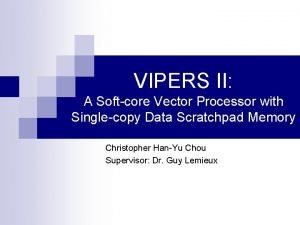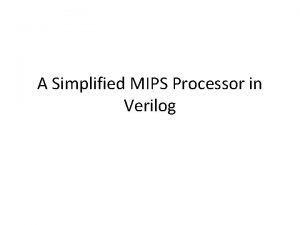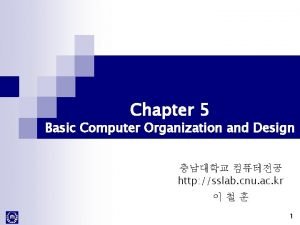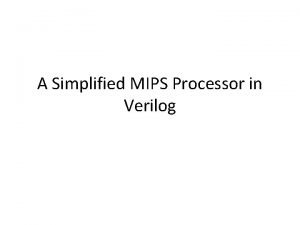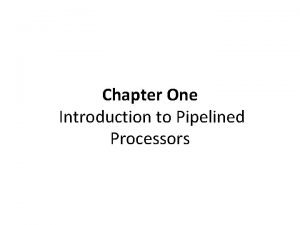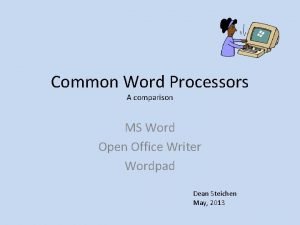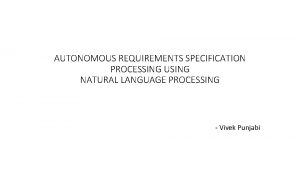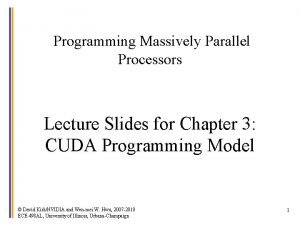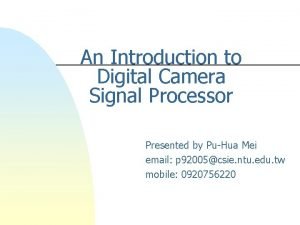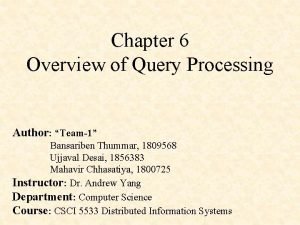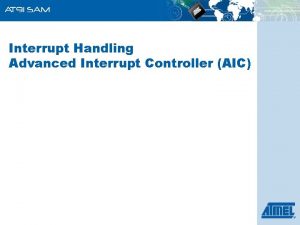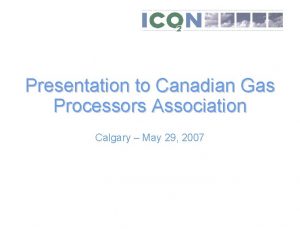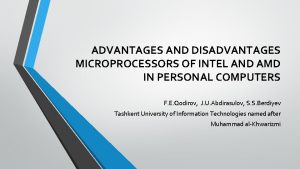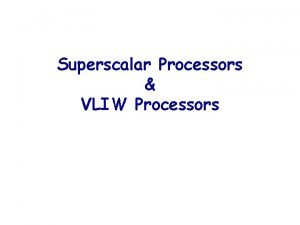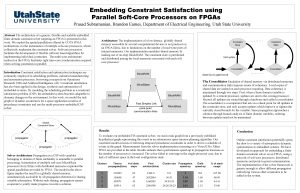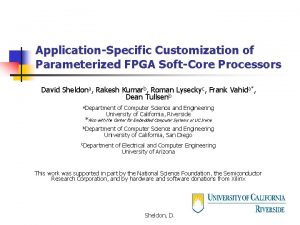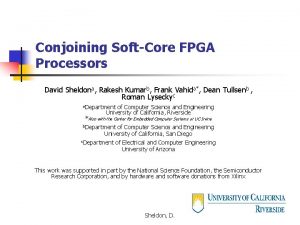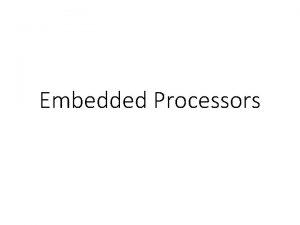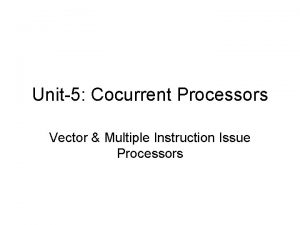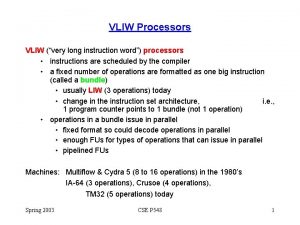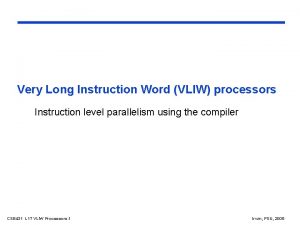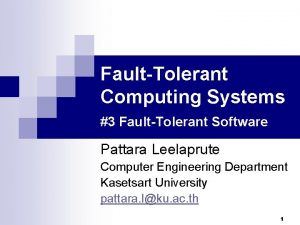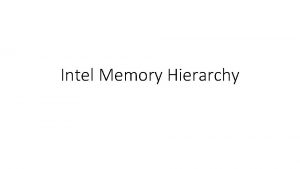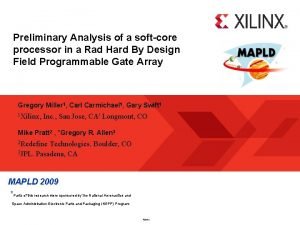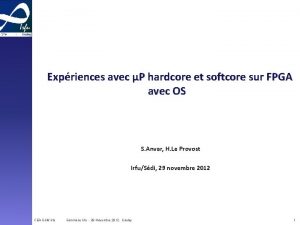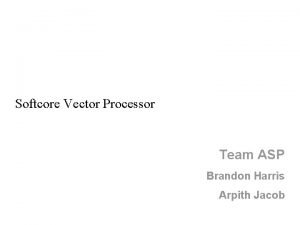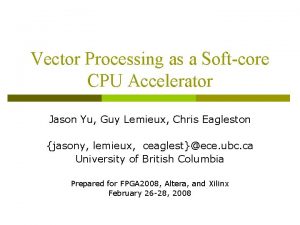FaultTolerant Softcore Processors Part I FaultTolerant Instruction Memory




















- Slides: 20

Fault-Tolerant Softcore Processors Part I: Fault-Tolerant Instruction Memory Nathaniel Rollins Brigham Young University

Overview n Strong interest in FT softcore processors in space q q n n n LEON processor used by European space program Microblaze, Pico. Blaze, 8051, ERC 32, etc. Rad-hard processors are expensive, big, and slow Softcore processors are flexible, fast, and cheap Overall Goal: identify low cost SEU mitigation techniques for softcore processors q Goal of Part I study: Identify low cost SEU mitigation techniques for softcore processor instruction memories 2

Approach n TMR is the most common mitigation technique q n BRAM 1 BRAM 2 Expensive and slow BRAM 3 Other hardware techniques q Detection isn’t good enough – must correct n n DWC alone isn’t good enough EDC alone isn’t good enough ECC BRAM voter Decode & Correct EDC with DWC ECC BRAM 1 Decode / Parity Scrubbing ECC BRAM do Compare Decode / Parity di WE n Study Approach q q FSM BRAM 2 Compare different softcore processor instruction memory fault-tolerant techniques in terms of: § Area, speed, power, reliability Remaining processor protection: plain TMR 3 ECC BRAM do di WE Decode / Parity

Fault Model n BYU/LANL SLAAC 1 V fault injection tool used to insert single bit upsets into Virtex FPGAs q q BRAM bits in Virtex bitstream are treated differently Task: upgrade fault injection tool to support: n n n Upsets in BRAM Readback of BRAM bits Next studies use SEAKR XRTC board with Virtex 4 FPGA q q SEAKR board borrowed from LANL Fault injection tool also upgraded to upset BRAMs and detect critical failures 4

Critical Failures n Critical Failures: upsets that cannot be fixed with a reset (lead to a SEFI) q Different memory structures are susceptible to critical failures: n n q BRAMs LUTRAMs SRLs Registers that are not tied to a global reset Example: WE port on a BRAM Data In Addr WE BRAM Data Out 5

Critical Failures n Critical Failures: upsets that cannot be fixed with a reset (lead to a SEFI) q Example: WE port on a BRAM 0 x 0000 0 x 07 0 BRAM AF 01 E 32 D 39 A 13 AA 1 00305 D 10 210 F 3111 0498100 F 64 D 1234 D. . . 0 x 3111 Instruction memory should never be written to → BRAM is treated as a ROM • input data lines tied low • WE tied low 6

Critical Failures n Critical Failures: upsets that cannot be fixed with a reset (lead to a SEFI) q Example: WE port on a BRAM 0 x 0000 0 x 07 1 BRAM AF 01 E 32 D 39 A 13 AA 1 00305 D 10 210 F 0000 0498100 F 64 D 1234 D. . . 0 x 0000 Upsetting the WE port overwrites the BRAM contents 7

Critical Failures n Critical Failures: upsets that cannot be fixed with a reset (lead to a SEFI) q Example: WE port on a BRAM 0 x 0000 0 x 1 D 1 BRAM AF 01 E 32 D 39 A 13 AA 1 00305 D 10 210 F 00000000. . . 0 x 0000 Especially bad for processors since BRAM address continually increments 8

Critical Failures n Critical Failures: upsets that cannot be fixed with a reset (lead to a SEFI) q Example: WE port on a BRAM 0 x 0000 0 x 00 0 n BRAM 00000000 00000000. . . 0 x 0000 Resetting the device will restart the processor, but will not restore the BRAM contents (program is lost)! Mitigation techniques need to eliminate critical failures 9

Fault-Tolerant Techniques n Original processor design: Xilinx Pico. Blaze Instruction ROM Address n Fault-tolerance determined by examining the PC and current instruction as faults are injected Output Pico. Blaze Processor Instruction memory fault-tolerant techniques: q TMR: § § § Single voter Triple voter Feedback BLTMR Scrubber q ECC: § § § q SEC/DED with DWC and scrubbing 10 EDC & DWC: § § CD with DWC and scrubbing

Fault-Tolerant Techniques: TMR Top-Level TMR – 1 voter Top-Level TMR – 3 voters Processor voter Processor voter BYU/LANL TMR Tool Feedback TMR R O M voter Processor v R O M BLTMR v v R O M Pico 11 Pico

n FT Techniques: TMR with Scrubbing BYU/Sandia BRAM scrubber with TMR q q Each BRAM scrubbing WE must be independent of other BRAM WEs Scrubbing address counters MUST be kept in sync Scrubbing counter must be 2 x slower than BRAM clock Must prevent read/write address conflicts BRAM a do di a WE Triplicated counter do v v Pico. Blaze v FSM Without scrubbing overlapping errors will cause TMR to fail BRAM a do di a do WE v Eliminating critical failures is difficult when BRAM WEs are upset FSM EN BRAM a do di a WE do v v Pico. Blaze FSM 12 v

FT Techniques: SEC/DED n SEC/DED on 16 -bit word: q q Use (22, 6) code on 16 -bit word Use 2 BRAMS: n n n 1 for top half encoded word (11 bits) 1 for bottom half encoded word (11 bits) Complete fault tolerance difficult when crossing from triplicated to non-triplicated q Logic and routing coming into and out of BRAMs are single point of failure encoded ROM (top half) Decode encoded ROM (bottom half) Decode v v v Pico. Blaze q SEC/DED: § v Pico. Blaze v 13 § § Detects and corrects any single-bit upset Detects any double-bit upset Triple+ upsets may or may not be detected

FT Techniques: SEC/DED with DWC n n Improve SEC/DED reliability with DWC Still susceptible to critical failures when BRAM WE is upset encoded ROM (top half) Decoder v 0 Decoder encoded ROM (bottom half) v Pico. Blaze v 1 Decoder 0 1 SEC/DED Module BRAM a 0 do 1 14

n FT Techniques: SEC/DED DWC Scrubbing uses dual ported BRAMs Scrub address counter runs ½ speed of BRAM clock q n Scrubbing cannot fix all errors (only single-bit/double-bit guaranteed) Scrub trigger: single error correction(SEC) or double error detection (DED) on current instruction – more than 2 errors may or may not be caught When triggered, a scrub copies entire BRAM contents of good BRAM into bad BRAM q q encoded ROM Triple CNT a a di we EN do 0 1 Decoder v Pico. Blaze v do 0 Decoder 1 encoded ROM a a di we we scrub. Data scrub. Addr addr do Decoder 0 FSM x 3 do SEC/DED Module err instruction 0 instruction 1 instruction 2 15 1

FT Techniques: CD with DWC n Complement Duplicate (CD) duplicates and inverts (complements) the original BRAM contents q n Detects errors by comparing the original with the complemented CD CD only detects upsets so DWC is used to correct upsets BRAM a do CD check 0 v Pico. Blaze 1 v CD check CD BRAM a q 0 do CD check v Pico. Blaze v 1 CD Module BRAM a do 0 1 16 CD detects: § § § Any single-bit upset 66% double-bit upsets Any multiple adjacent unidirectional upset

FT Techniques: CD DWC Scrub n Scrubbing uses dual ported BRAMs Scrub address counter runs ½ speed of BRAM clock q n Scrubbing will fix critical failures Scrubbing trigger: inverse of current instruction doesn’t match CD contents When triggered, a scrub copies entire BRAM contents of good BRAM into bad BRAM There are other scrubbing design strategies with CD – but this one removes all critical failures q q q Triple CNT EN BRAM 0 a do a di we do 1 CD Check 0 CD Check 1 v Pico. Blaze v CD BRAM a do a di do we we scrub. Data scrub. Addr addr CD Module CD Check 0 FSM x 3 err instruction 0 instruction 1 instruction 2 17 1

FT Techniques: Results Design Slices BRAM Bits Clock Rate (MHz) Power (m. W) Sensitive Bits Critical Failures Original 70 560 65. 5 49 2881 3 1 voter 227 3. 2 x 1680 3 x 67. 5 1. 03 x 66 1. 35 x 847 3. 4 x 3 3 voters 252 3. 6 x 1680 3 x 71. 4 1. 09 x 75 1. 53 x 36 80. 0 x 3 Feedback 250 3. 6 x 1680 3 x 66. 1 1. 01 x 73 1. 49 x 68 42. 4 x 3 BLTMR 297 4. 2 x 1680 3 x 63. 9 1. 03 x 76 1. 55 x 52 55. 4 x 3 TMR Scrub 348 5. 0 x 1680 3 x 58. 4 1. 12 x 82 1. 67 x 28 102. 9 x 0 SEC/DED 340 4. 9 x 770 1. 4 x 43. 4 1. 51 x 82 1. 67 x 711 4. 1 x 16 SEC/DED DWC 373 5. 3 x 1540 2. 8 x 42. 7 1. 53 x 89 1. 82 x 473 6. 1 x 3 SEC/DED DWC Scrub 545 7. 8 x 1540 2. 8 x 32. 4 2. 02 x 105 2. 14 x 326 8. 8 x 0 CD DWC 235 3. 4 x 2240 4 x 47. 9 1. 37 x 72 1. 47 x 1034 2. 8 x 2 CD DWC Scrub 395 5. 6 x 2240 4 x 29. 7 2. 21 x 90 1. 84 x 231 12. 5 x 0 Clock and reset lines are NOT triplicated 18

Conclusions n Reliability q For instruction memories, TMR with scrubbing provides the best protection n n q n Fewest sensitivities Eliminates critical failures Scrubbing is required to eliminate critical failures Costs q TMR is more effective than SEC/DED and CD with DWC n n q Better protection Lower area, speed, and power costs SEC/DED and CD with DWC scrubbers are very expensive 19

n FT Softcore Processors: Moving Forward Next General Studies: q q n Create different fault models for SEAKR board q q n Memory Study: BRAMs & LUTRAMs Software fault-tolerant techniques study Multi-bit upset model Temporal fault-tolerant techniques model Combinations of different fault-tolerant techniques PC SEC/DED PC Control Logic DWC & Scrubbing Reg File Memory Control Flow Monitoring Control Logic Reg File Memory ALU Stack Checkpointing TMR & Scrubbing IR CC ALU IR Stack Pico. Blaze CC Pico. Blaze 20
 Softcore the n
Softcore the n Individualized instruction vs differentiated instruction
Individualized instruction vs differentiated instruction Site:slidetodoc.com
Site:slidetodoc.com Instruction memory verilog
Instruction memory verilog Bsa in computer architecture
Bsa in computer architecture Mips data memory
Mips data memory Unifunction and multifunction pipeline
Unifunction and multifunction pipeline Network systems design using network processors
Network systems design using network processors Comparison of word processors
Comparison of word processors Microcontrollers and embedded processors
Microcontrollers and embedded processors Non linear pipeline processor
Non linear pipeline processor Language and processors for requirement
Language and processors for requirement Massively parallel processing ppt
Massively parallel processing ppt Digital camera processors
Digital camera processors Explain single pass macro processor
Explain single pass macro processor Layers of query processing
Layers of query processing Interrupt handling in arm processors
Interrupt handling in arm processors Networks and telecommunications presentation
Networks and telecommunications presentation Gas processors association
Gas processors association Advantages and disadvantages of intel processors
Advantages and disadvantages of intel processors Vliw vs superscalar
Vliw vs superscalar
